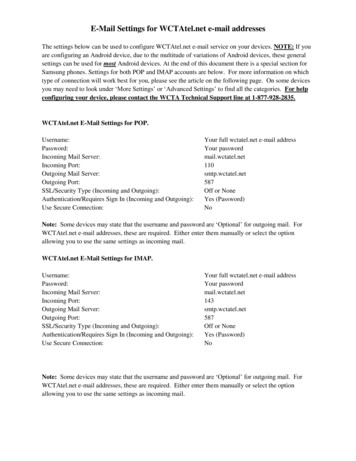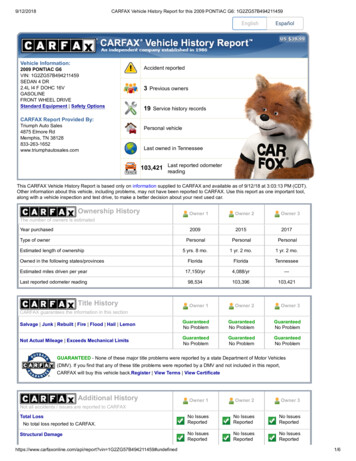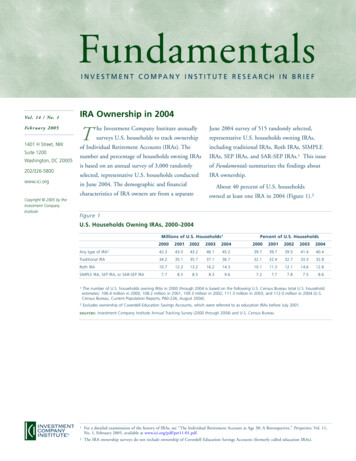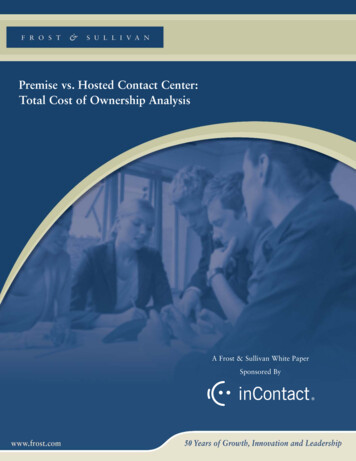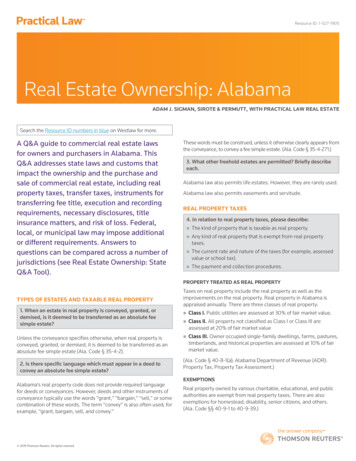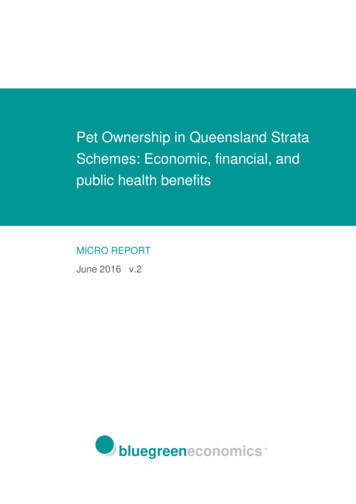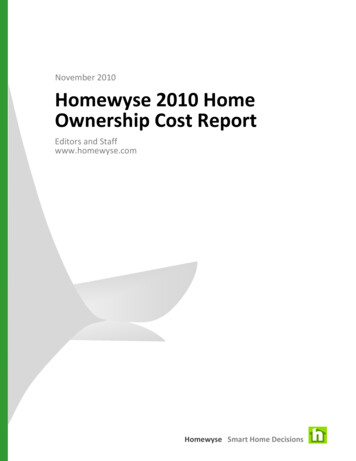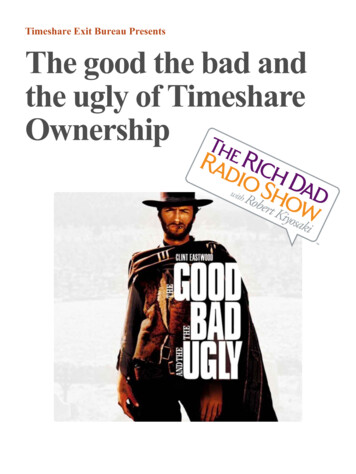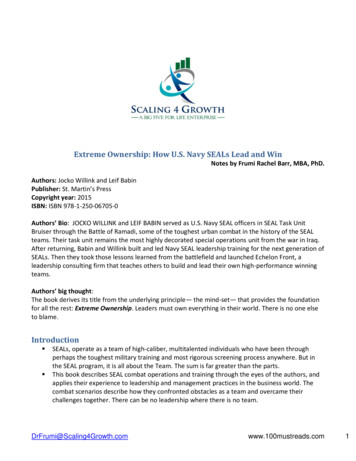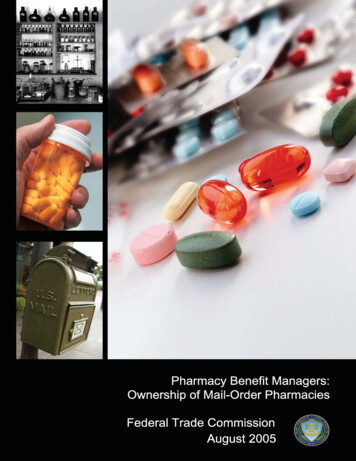
Transcription
Federal Trade CommissionDEBORAH PLATT MAJORASTHOMAS B. LEARYPAMELA JONES HARBOURJON nerMaryanne KaneCharles H. SchneiderSusan A. CreightonLydia B. ParnesMichael SalingerWilliam BlumenthalAnna H. DavisNancy Ness JudyMaureen K. OhlhausenDonald S. ClarkChief of StaffExecutive DirectorDirector, Bureau of CompetitionDirector, Bureau of Consumer ProtectionDirector, Bureau of EconomicsGeneral CounselDirector, Office of Congressional RelationsDirector, Office of Public AffairsDirector, Office of Policy PlanningSecretary of the CommissionReport Drafters and ContributorsMichael S. Wroblewski, Assistant General Counsel for Policy StudiesDavid R. Schmidt, Bureau of EconomicsPatricia Schultheiss, Bureau of CompetitionKaren A. Goldman, Office of General Counsel Policy StudiesRandall Marks, Bureau of CompetitionSusan DeSanti, Deputy General Counsel for Policy StudiesSarah M. Mathias, Office of General Counsel Policy StudiesElizabeth Jane Argeris, Bureau of CompetitionNatalie Shonka, Office of General Counsel Policy StudiesMahlon Wigton, Bureau of EconomicsInquiries concerning this report should be directed to:Michael S. Wroblewski at (202) 326-2155 or mwroblewski@ftc.govAcknowledgments:The FTC staff appreciates the cooperation of all of the companies subject to theSpecial Orders and their timeliness in providing requested additional materials.
EXECUTIVE SUMMARYFor millions of Americans, breakthroughs in medical research have allowed prescriptiondrugs to save lives, reduce suffering, and enhance life. But these breakthroughs come with aprice: increased usage and rising prices have pushed prescription drug expenditures to 179.2billion in 2003, or 10.7% of national health expenditures. Prescription drugs are the most rapidlyincreasing component of U.S. health care costs.Against this backdrop, Congress in 2003 added a new benefit to Medicare that providessenior citizens and other Medicare beneficiaries with a voluntary prescription drug benefitbeginning in 2006. The new benefit relies heavily on private sector entities and competition toensure that Medicare enrollees have a choice of prescription drug plans.Private sector entities that offer medical insurance (“plan sponsors”), such as employers,labor unions, and managed care companies, also offer prescription drug insurance coverage.Plan sponsors often hire pharmacy benefit managers (PBMs) to manage these insurance benefits.This Study examines one facet of private sector competition – how PBMs’ use of mail-orderpharmacies that they own affects their clients’ prescription drug costs.PBMs engage in many activities to manage their clients’ prescription drug insurancecoverage. PBMs assemble networks of retail pharmacies so that a plan sponsor’s members canfill prescriptions easily and in multiple locations by just paying a copayment amount. PBMsconsult with plan sponsors to decide for which drugs a plan sponsor will provide insurancecoverage to treat each medical condition (e.g., hypertension, high cholesterol, etc.). The PBMmanages this list of preferred drug products (the “formulary”) for each of its plan sponsor clients.Consumers with insurance coverage are then provided incentives, such as low copayments, touse formulary drugs. Because formulary listing will affect a drug’s sales, pharmaceuticalmanufacturers compete to ensure that their products are included on these formularies. They doso by paying PBMs “formulary payments” to obtain formulary status, and/or “market-sharepayments” to encourage PBMs to dispense their drugs. These payments are based on thequantity of drugs dispensed under the plans administered by the PBM.PBMs use mail-order pharmacies to manage prescription drug costs. Many plan sponsorshave encouraged patients with chronic conditions who require repeated refills to seek thediscounts that 90-day prescriptions and high-volume mail-order pharmacies can offer. ManyPBMs own their own mail-order pharmacies. These PBMs have suggested that they have greatercontrol over the drugs dispensed through mail-order pharmacies and, therefore, can providegreater formulary compliance.And this is where the controversy lies. If a plan sponsor’s agreement with a PBM doesnot properly align the plan’s interests with the PBM’s incentives, there could be a conflict ofinterest. Although PBMs are tasked to manage and lower the costs of pharmacy benefits, intheory they could have incentives to increase costs and generate additional profits through theirmail-order pharmacies. Congress requested that the Federal Trade Commission (FTC orCommission) determine whether a PBM that owns a mail-order pharmacy acts in a manner thati
PHARMACY BENEFIT MANAGERS:maximizes competition and results in lower prescription drug prices for its plan sponsormembers.At the request of Congress, the Commission collected aggregate data on prices, genericsubstitution and dispensing rates, savings due to therapeutic drug switches (“therapeuticinterchange”), and repackaging practices. These data provide strong evidence that in 2002 and2003, PBMs’ ownership of mail-order pharmacies generally did not disadvantage plan sponsors.Because these data are aggregated, they do not answer whether each plan sponsor has negotiatedthe best deal possible or whether each PBM has fulfilled its contractual obligations due to eachof its plan sponsor clients. The data also do not indicate whether, in individual instances, a PBMmight have favored its mail-order pharmacy in ways contrary to a plan sponsor’s interests.Nonetheless, these data suggest that competition in this industry can afford plan sponsors withsufficient tools to safeguard their interests.Congressional RequestCongress requested in the Medicare Prescription Drug, Improvement, and ModernizationAct of 2003 (MMA) that the Federal Trade Commission undertake a “Conflict of Interest Study”to examine “differences in payment amounts for pharmacy services provided to enrollees ingroup health plans that utilize pharmacy benefit managers,” including:(1) An assessment of the differences in costs incurred by such enrollees and plansfor prescription drugs dispensed by mail-order pharmacies owned bypharmaceutical benefit managers compared to mail-order pharmacies not ownedby pharmaceutical benefit managers and community pharmacies (Question 1).(2) Whether such plans are acting in a manner that maximizes competition and results inlower prescription drug prices for enrollees (Question 2). 1As explained in the Conference Report for the MMA, Congress requested that theCommission determine whether the use of mail-order pharmacies owned by PBMs thatadminister the Medicare prescription drug benefit would adversely affect Medicare spending, ascompared to the use of mail-order pharmacies not owned by a PBM. Accordingly, Congressasked the FTC to consider the following business practices:(1) whether mail-order pharmacies that are owned by PBMs (or entities that ownPBMs) dispense fewer generic drugs compared to single source drugs within thesame therapeutic class than mail order pharmacies that are not owned by PBMs(Question 3);(2) whether mail-order pharmacies that are owned by PBMs (or entities that ownPBMs) switch patients from lower-priced drugs to higher-priced drugs (in the1See Medicare Prescription Drug, Improvement, and Modernization Act of 2003, Pub. L. No. 108-173, tit.I, § 110, 117 Stat. 2066, 2174 (2003) (codified at 42 U.S.C. § 1395w-101 (Historical and Statutory Note)).iiFEDERAL TRADE COMMISSION, AUGUST 2005
OWNERSHIP OF MAIL-ORDER PHARMACIESabsence of a clinical indication) more frequently than mail-order pharmacies thatare not owned by PBMs (Question 4);(3) whether mail-order pharmacies owned by PBMs (or entities that own PBMs)sell a higher proportion of repackaged drugs than mail-order pharmacies that arenot owned by PBMs (Question 5a);(4) whether mail-order pharmacies owned by PBMs (or entities owned by PBMs)sell repackaged drugs at prices above the manufacturer’s average wholesale price(Question 5b); and(5) other factors deemed relevant by the FTC. 2Finally, Congress requested that the FTC “consider whether competition or drug pricingbehavior by PBMs would be affected if PBMs were to bear financial risk for drug spending.”(Question 6) 3The Commission’s Approach to the Conflict of Interest StudyThe Commission used a two-stage process to collect the company-specific informationand data necessary to complete the study. 4 During the first stage, the Commission identified fourgroups of participants and issued Special Orders that subpoenaed data and documents. TheCommission included PBMs that owned mail-order pharmacies and those that did not, so that itcould assess the differences in prices for prescription drugs dispensed by mail-order pharmaciesowned by PBMs compared to both mail-order pharmacies not owned by PBMs and communitypharmacies. The Commission also obtained data from four large stand-alone retail pharmacies toassess the price differences for customers with insurance and those that paid cash for theirprescriptions. The four groups of study participants included the following: Large PBMs: Medco Health Solutions, Inc., Express Scripts, Inc., and Caremark Rx,Inc. 5 Small and Insurer-Owned PBMs: Aetna Inc., Cigna Corporation, NationalMedical Health Card Systems, Inc., Prime Therapeutics, Inc., Restat LLC, andWellpoint Health Networks, Inc. Retailer-Owned PBMs: Eckerd Health Systems (formerly a subsidiary of Eckerd Corp.),PharmaCare Management Services (a subsidiary of CVS Corp.), RxAmerica (a2H.R. CONF. REP. NO. 108-391 at 519-520 (2003), reprinted in 2003 U.S.C.C.A.N. 1808, 1891.3Id. at 520.4See FTC, “Pharmacy Benefit Manager Conflict of Interest Study, Public Notice,” (Mar. 26, 2004), aremark completed its acquisition of Advance PCS in 2004. For purposes of this report, the data fromCaremark and Advance PCS were reported separately.EXECUTIVE SUMMARYiii
PHARMACY BENEFIT MANAGERS:subsidiary of Longs Drug Stores Corp.), Walgreens Health Initiative (a subsidiary ofWalgreen Co.). 6 Stand-Alone Retail Pharmacies: CVS Corp., Longs Drug Stores Corporation,Rite Aid Corporation, Wal-Mart Stores, Inc., Walgreen Co., and Argus HealthSystems, Inc. 7The data and documents subpoenaed included high-level business documents andaggregate data for three business practices (generic substitution and dispensing, therapeuticinterchange, and repackaging practices). The Commission obtained agreements between plansponsors and PBMs to examine how PBMs price their services to their clients. In addition, theCommission obtained agreements between pharmaceutical manufacturers and PBMs to examinehow pharmaceutical manufacturers compete in this area.These data permitted the Commission to compare differences in business practices basedon three factors: (1) PBM category (i.e., large PBM, small or insurer-owned PBM, retailerowned PBM); (2) dispensing channel (i.e., mail vs. retail); and (3) ownership of the dispensingchannel (i.e., owned mail, not-owned mail, owned retail, not-owned retail).In the second round of information collection, the Commission obtained individualclaims data for December 2003 from a subset of the companies listed above. These companiesincluded all large independent PBMs, one small or insurer-owned PBM, two retailer-ownedPBMs, and two stand-alone retailers. These data permitted the Commission to examine PBMs’business practices in more depth.Background on the PBM BusinessAs noted earlier, many health plan sponsors offer their members prescription druginsurance and hire PBMs to manage these pharmacy benefits on their behalf. As part of themanagement of these benefits, PBMs assemble networks of retail and mail-order pharmacies sothat the plan sponsor’s members can fill prescriptions easily and in multiple locations.When a consumer fills a prescription at a local pharmacy, the pharmacist usually askswhether the consumer has insurance to cover the prescription s cost. If there is coverage, theconsumer provides the insurance card to the pharmacist. While the pharmacist fills theprescription, sophisticated computer interactions between the pharmacy and the PBM ensure thatthe prescription is filled according to the insurance coverage provided by the plan sponsor. Theconsumer usually is unaware of these processing interactions, and the consumer’s only additionalresponsibility is to pick up the filled prescription and pay the retail pharmacy the copayment thatis due.6In 2004, CVS completed its acquisition of Eckerd. For purposes of this report, the data from PharmaCareand Eckerd Health Systems (EHS) were reported separately.7Argus Health Systems processes third-party claims for PBMs. Unlike the stand-alone retailers in thisgroup, Argus did not provide data for cash-paying customers.ivFEDERAL TRADE COMMISSION, AUGUST 2005
OWNERSHIP OF MAIL-ORDER PHARMACIESOther services a PBM may perform as the pharmacist fills the prescription include,among other things, automatic checks on whether: (a) there will be interactions with otherpharmaceutical products the consumer may be taking, (b) a generic version of the prescribeddrug is available, and (c) enough days have passed before a prescription can be refilled. Theseclaims adjudication and other more sophisticated services are often referred to as themanagement and design of pharmacy benefits that PBMs provide to their clients.A PBM’s clients include entities that provide prescription drug insurance to theirenrollees or members. These entities generally include, for example, Health MaintenanceOrganizations (HMOs), self-insured employers, labor union plans, and other entities that have“carved out” the administration of pharmacy benefits from other health or medical benefits.Many large insurers, however, offer “in-house” PBM services to their plan sponsors.Throughout this report, a PBM’s clients are referred to as “plan sponsors” or “plans” and a plan’senrollees are referred to as “members.”Approximately 40 to 50 PBMs operate in the United States today. 8 The relative size andranking of PBMs vary according to the measure used, i.e., annual prescription expenditures,prescriptions per year, or the number of enrollees covered by a plan (i.e., “covered lives”). 9Approximately 12 PBMs have more than five million covered lives. 10 The market share figures,as well as the documents of almost all of the study participants, described an industry in whichthe three large PBMs (all of which are study participants) are the major players, and severalinsurer-owned PBMs and retailer-owned PBMs have a substantial market presence.PBM Ownership of Mail-Order PharmaciesA PBM that owns a pharmacy (whether retail or mail) is considered vertically integrated.A vertically integrated PBM may have a greater ability to influence which drugs are dispensedunder the plans it administers than a non-vertically integrated PBM. If plan sponsor contractswith PBMs do not properly align the incentives of PBMs with those of the plans, this lack ofalignment could create a conflict of interest. Potential conflicts of interest should be rare,however, if competition among PBMs provides plan sponsors with alternative choices.The economic literature on vertical integration suggests that it can lower costs. First,integration can reduce transaction costs. In addition, it also avoids double markups (or whateconomists call “double marginalization”) in which two independent, vertically related firmseach have some ability to charge above marginal cost. A PBM that owns a mail-order pharmacymay have an incentive to charge a lower overall price for the product than two independententities setting prices optimally.8Robert F. Atlas, The Role of PBMs in Implementing the Medicare Prescription Drug Benefit, 2004HEALTH AFFAIRS (Web Exclusive), W4-504, 506, tract/hlthaff.w4.504.910Atlas, supra note 8, at 506.Id.EXECUTIVE SUMMARYv
PHARMACY BENEFIT MANAGERS:Nonetheless, some have alleged that a conflict of interest arises when PBMs bothadminister the pharmacy benefits for a client and sell drugs to a client’s members via the PBM’sowned mail-order pharmacy. These “self-dealing” arrangements purportedly would providePBMs an opportunity to manipulate drug dispensing at their mail-order pharmacies to enhancetheir own profits at the expense of plans and members through the three business practicesdiscussed above (lack of generic substitution and dispensing, interchange to more expensivebrand products, and repackaging of drugs into more expensive units). One study concluded onthe basis of high level data and theoretical calculations that self-dealing could cost the U.S.Government and Medicare beneficiaries up to 30 billion during the period 2004-2013. 11The actual data from the study participants on the business practices Congress requestedthe FTC to study revealed that these allegations are without merit. The following discussionprovides a summary of the data and information produced by the study participants to answer thesix questions in the MMA and its Conference Report.Question 1: Assessment of Price Differences in Payment Amounts Incurred by Plans andtheir Members for Prescription Drugs Dispensed by Mail-Order Pharmacies Owned byPBMs Compared to Non-Owned Mail-Order Pharmacies and Retail Pharmacies.Background on How the Commission Collected Price Data: The Commission collected2002 and 2003 price data for three types of drug products (single-source brand (SSB), multisource brand (MSB), and generic (G) drugs) from each study participant. 12 The price dataincluded the total amounts that members and plans paid, regardless of how various PBMs andplan sponsors labeled those outlays. Member prices included the sum of copayment, deductible,and any coinsurance amounts. Plan prices included the sum of ingredient costs (the portion ofthe dispensed drug for which the plan pays), dispensing fees, and any pharmaceutical paymentsshared with the plan that reduced the prices plan sponsors paid. For purposes of this report,“total price” equals the sum of “member price” and “plan price.”Answer -- Differences in average total 2002 and 2003 prices at owned mail-orderpharmacies versus not-owned mail-order pharmacies for each drug type: For large PBMs, average total prices at owned mail-order pharmacies typically werelower than at mail-order pharmacies not owned by the large PBMs.11See JAMES LANGENFELD & ROBERT MANESS, THE COST OF PBM “SELF-DEALING” UNDER A MEDICAREPRESCRIPTION DRUG BENEFIT 30-31 (2003) [hereinafter SELF-DEALING STUDY], athttp://www.mpaginc.com/news/pbmreport.pdf. This study, financed by several retail pharmacies, concluded on thebasis of aggregate data and numerous simplifying assumptions that self-dealing would cost the U.S. Governmentand Medicare beneficiaries billions of dollars during the period 2004-2013. See Carol Ukens, PBM Mail OrderWould Up Medicare Rx Cost, Study Finds, DRUG TOPICS, Oct. 6, 2003, at 34, icleDetail.jsp?id 111109.12The biggest difference between single-source and multi-source brand drugs is that single-source branddrugs do not have a generic alternative, whereas multi-source brand drugs do. For example, as of August 2005among antidepressants, Zoloft is a single-source brand drug. Prozac is a multi-source brand drug, and fluoxetine(the active ingredient in Prozac) is a generic drug.viFEDERAL TRADE COMMISSION, AUGUST 2005
OWNERSHIP OF MAIL-ORDER PHARMACIES Retailer-owned PBMs charged lower total average prices for generic and MSB drugs, butnot for SSB drugs, at their owned mail-order pharmacies compared to not-owned mailorder pharmacies.The data showed that mail prescriptions are typically three times as large as retail prescriptions(e.g., 30 days at retail and 90 days at mail). 13 Moreover, the mix of drugs dispensed variessubstantially across dispensing channels – mail-o
Aug 10, 2005 · Aug 10, 2005 · PBMs use mail-order pharmacies to manage prescription drug costs. Many plan sponsors have encouraged patients with chronic conditions who require repeated refills to seek the . 4 See FTC,
